Growing health fears as plutonium discovered at Fukushima
As plutonium radiation is discovered outside Japan’s Fukushima plant, Channel 4 News explains the long-term health risks of the fallout for generations to come.

Plutonium traces have been found in soil around the Fukushima-Daiichi plant, according to the Tokyo Electrical Power Company (Tepco). The presence of plutonium was found at a number of sites across the Fukusima-Daiichi plant in samples taken a week ago.
Plutonium is a highly dangerous form of radioactive material, rarely found in nature, but created in mass quantities for military and commercial use. Despite this discovery in five different places around the plant, Tepco have confirmed workers will continue their battle to control the nuclear event.
Prolonged exposure can result in damage to the surface of the skeletal bones. It can be ingested by air or in food, and the discovery of its presence heightens the fears of long-term damage caused by the explosions at the plant. De-contamination of the surrounding farm land, if also affected by plutonium fallout, would be costly and raise fears in Japan that they are eating already-infected food.
Retracted figures
The crisis at the Fukushima nuclear plant took a dramatic turn on Sunday, as Tepco released radiation readings 10 million times higher than the normal recommended levels and removed workers from the plant. These figures were later retracted as a mistake but the incident raised yet more questions about the disaster-hit plant.
Despite the lack of accuracy over these figures, more problems were confirmed over the weekend at the plant. Dangerously-high levels of radiation had accrued in a turbine housing unit, forcing workers to be removed from the station. In addition, high-level traces of radioactive iodine-131, which can lead to lymph cancer and is particularly dangerous to foetuses and young children, have been found in sea water 300m away from the plant – 1,250 times above the benchmark considered to be safe.
Nuclear and environmental scientists in the United States darkened their assessment of the risks markedly on Monday after operators at the Fukushima Daiichi power plant said that highly radioactive water has entered underground concrete tunnels extending beyond the reactor.
Sea water and fresh water used to cool the reactors, critically damaged by Japan’s March 11 earthquake and tsunami, and spent fuel pools at the plant have been put in storage tanks there. But reports indicate these tanks are full or over-flowing with tainted water, experts said.
“It’s just hard to see how this won’t result in significant contamination of, certainly, sea water,” said Edwin Lyman, a physicist and expert on nuclear plant design at the U.S.-based Union of Concerned Scientists.
Sea contamination is a concern for the Japanese, who consume about 9 million tons of seafood a year, second behind China.
Jon Snow wrote in his Snowblog on Monday: "It is proving hard to get Japan out of my mind. The continual drip-drip of ever-worsening news about the Fukushima Nuclear plant has somehow overwhelmed the continuing awfulness of the consequences of the natural disaster itself. I guess the tangible disaster, vast though it is, is somehow more determinable than the unseen, unknown quantity of danger residing in the reactors, or outside them, in Fukushima.
"So what becomes of a big, and presumably continuing, dumping of radio active material in sea water off Japan. When will it pitch up off Cornwall? Never? Do we know? Will it cause cancers? Will it kill eventually? These days we are told Chernobyl actually killed relatively few people. It deformed some babies, cancer rates increased, but somehow precision in the world's worst nuclear accident, even after all these years, eludes us."
Channel 4 News spoke to John Large, an independent nuclear engineer and analyst, to explain the situation in Fukushima and beyond. The startling conclusion is that levels recorded – although far below those at Chernobyl – could result in a major health impact, lasting for generations.

Mortality figures
“Mortality figures for Chernobyl have been tugged too and fro between the nuclear and environmental interests. As of 2005, fewer than 50 deaths could be directly attributed to radiation from the disaster, yet in the same year a forum of eight UN specialised agencies, including the World Health Organisation (WHO) and International Atomic Energy Agency (IAEA) reported that up to 4,000 people could die as a direct consequence of being exposed to radiation over the 20-plus years since the incident. In this report they claimed that of the 200,000 emergency workers exposed between 1986-87, an estimated 2200 radiation caused deaths can be expected during this lifetime.”
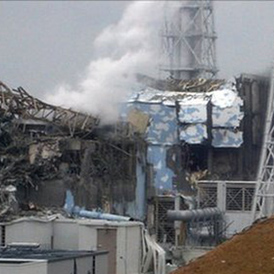
The ’10 million’ figure
“Geiger counter blips on every disintegration and doesn’t detail if it is iodines, caesium, plutonium or any of the other one hundred or so radionuclides likely to be included in the radioactive release. What you need to determine the radio discharge is a gamma spectrometer but even then, it is notoriously difficult to get an accurate reading unless you are in a laboratory. It’s very difficult to get these radiologically-sterile conditions in a plant contamnated by the incident itself.”

Sea water radiation
“Iodine131 is what has been found in the sea water off the coast around Fukushima. The half life of this is about 8 days, it radioactively decays to innocuous levels over, say, 15 half lifes and so will be (radio)actively present for up to 6 months. If you respire Iodine131 or it contaminates milk or water, its uptake into the human body gives rise to risk of thyroid cancer where the radioactive iodine re-concentrates. However, Iodine131 in a marine environment is a long way from the human environment and it has to transfer through several paths before it is available for human uptake.”
- Chapters
- descriptions off, selected
- subtitles off, selected
- captions settings, opens captions settings dialog
- captions off, selected
This is a modal window.
This is a modal window. This modal can be closed by pressing the Escape key or activating the close button.
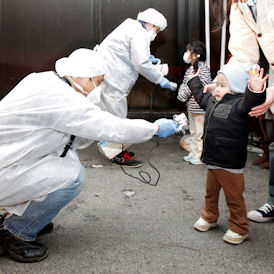
The exlusion zone – at Fukushima a 20km zone is still in place
“It’s a question of logistics. The Radiation (Emergency Preparedness and Public Information) Regulations of 2004 states that UK nuclear plants which have had a major incident will have a zone of 1.5km with other automatic evacuations and other counter-measures. That could extend to 3km, and generally be capable of extending to 10. Generally it is unnecessary to implement counter-measures entirely around (radially) the plant beyond 3km, the reason is by the time you get out to 10, 20, 30km the radiation will have formed a distinctive plume, like a teardrop, not the erratic swirling that could take place in the close vicinity of the plant.
“As the tear drop develops it will do so roughly at a 30 degree taper so the density at the front is dropping down in relation to its radial length. At 10 km and beyond you chase the plume and see where it is going, under the plume, going from radial approach to a sector approach. If the wind starts swinging around, the people under the next sector start from scratch, so you have time to evacuate them according to their exposure which runs from the time that the plume changed direction to drift over them.
“The radial width of the zone in Japan, would indicate the severity of the damage incurred across the six reactors.”
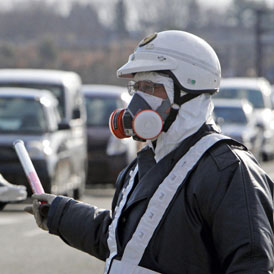
Tokyo risk
“For an urban conurbation like Tokyo, firstly, from the overhead radiation cloud you get shine – gamma rays, that will result in external body dose. If the plume descends, depending on atmospheric conditions, on the buoyancy of individual pieces of radium, caesium, plutonium and many other species of radioactive particle in the release, then it can be breathed in.
“If you take a radio-nuclide into your body it will pass through your lungs and into your blood system, Iodine can effect your thyroid, plutonium the surface of the skeletal bones, caesium in tissue, strontium in lungs, and so on. Once in your system these forms of radiation can take years to decay. This indicates how difficult it is to see how many people, over the years, will die as a causal link to the radiation they are exposed to. A figure cannot be given but an increased risk to a huge population (35 million people in Tokyo) is clear.”
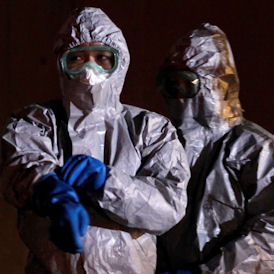
The plant workers
“The people working at the plant may be subject to acute levels of radiation that are so high they may cause bodily malfunction quickly. Workers have received beta burning on site for example. A worker in the plant would normally work to a maximum annual exposure level of 12 millisieverts a year (mSv/y), a firefighter can be exposed to 50 mSv/y, females are not allowed to attend radiation-related incidents whilst lifesavers can be subjected to 100 milisieverts. In the Fukushima plant the level was raised to 250 mSv/y, at that level you then get irrecoverable changes in your blood system. If you are subject to up to 1000mSv you start to have immediate problems: cough, vomit, balance. Up to 5 to 10 sieverts and you’d expect to see death in the first few weeks, 15-20 sieverts would be certain fatality.
“Some of the typical doses at Chernobyl were 5 sieverts, far above the exposure of those working within the plant.
“As for people in the vicinity of the plant, it has been worked out that full exposure to the levels of radiation dose accummulated that have been recorded would amount to an estimated 36mSv over the first 15 days of the event. If other factors are added into the calculation, staying indoors, moving around in different radiation levels, then this exposure would be markedly reduced.”
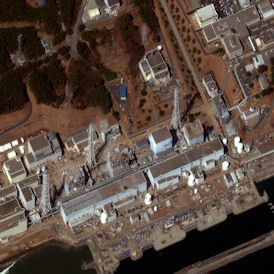
The cost
“The clean-up at Three Mile Island cost $997m in the 1980s, for one reactor, that contained almost all of the radioactivity. At Fukushima we have six reactors with radioactive fuel all over the site and the estimated clean-up and generating capacity replacement costs in the order of $50 billion before claims from land owners and the decontamination process.”